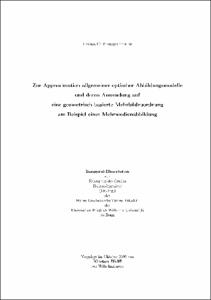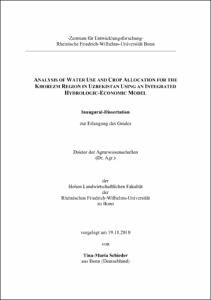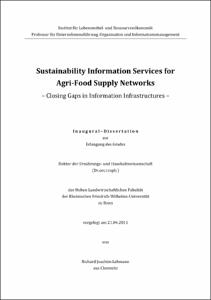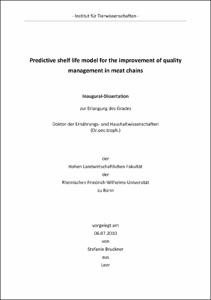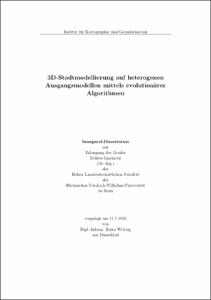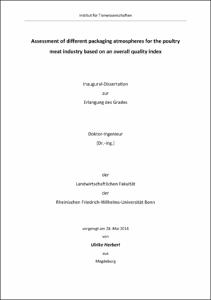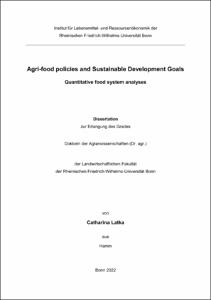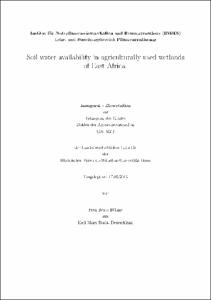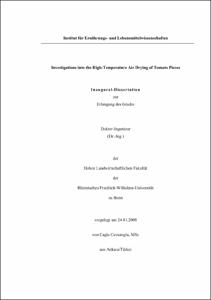E-Dissertationen: Suche
Anzeige der Dokumente 1-9 von 9
Zur Approximation allgemeiner optischer Abbildungsmodelle und deren Anwendung auf eine geometrisch basierte Mehrbildzuordnung am Beispiel einer Mehrmedienabbildung
(2007)
Nicht perspektivische Abbildungen besitzen geometrische Elemente, die auf ihre geometrischen Eigenschaften einen direkten Einfluss haben, im Bereich der Photogrammetrie aber kaum bekannt sind. Ein solches Element ist zum ...
Analysis of Water Use and Crop Allocation for the Khorezm Region in Uzbekistan Using an Integrated Hydrologic-Economic Model
(2011-04-20)
Sustainable and efficient water management is of central importance for the dominant agricultural sector and thus for the population and the environment of the Khorezm region. Khorezm is situated in the lower Amu Darya ...
Sustainability Information Services for Agri-Food Supply Networks: Closing Gaps in Information Infrastructures
(2011-07-14)
Several global developments (e.g. diminishing production resources, growing demand for bio-energy) and numerous sector-wide crises (e.g. BSE, swine fever, dioxin) have led to a changing attitude of society towards the ...
Predictive shelf life model for the improvement of quality management in meat chains
(2010-09-21)
The objective of this thesis was the development of a common predictive shelf life model for fresh pork and fresh poultry based on the growth of Pseudomonas sp. as specific spoilage organism (SSO). As an element of ...
3D-Stadtmodellierung auf heterogenen Ausgangsmodellen mittels evolutionärer Algorithmen
(2007)
Die vorliegende Arbeit beschreibt ein neuartiges Verfahrens zur flexiblen und effizienten 3D-Stadtmodellierung im Kontext der Verfügbarmachung von 3D-Stadtmodellen. Ausgangspunkt ist die Heterogenität existierender und ...
Assessment of different packaging atmospheres for the poultry meat industry based on an overall quality index
(2014-11-10)
The objective of this thesis was the development of an Overall Quality Index (OQI) for modified atmosphere packaged (MAP) poultry fillets to compare and to assess the influence of different environmental factors on the ......
Bewertung unterschiedlicher Gaszusammensetzungen für die Geflügelfleischindustrie auf Grundlage eines Gesamtqualitätsindex
Das Ziel der vorliegenden Arbeit war die Entwicklung eines Gesamtqualitätsindex ......
Bewertung unterschiedlicher Gaszusammensetzungen für die Geflügelfleischindustrie auf Grundlage eines Gesamtqualitätsindex
Das Ziel der vorliegenden Arbeit war die Entwicklung eines Gesamtqualitätsindex ......
Agri-food policies and Sustainable Development Goals: Quantitative food system analyses
(2022-08-23)
The agricultural and food system is key to reaching several of the Sustainable Development Goals (SDGs), foremost those on food security (SDG2), reducing waste (SDG12), combatting climate change (SDG13), and reducing ...
Soil water availability in agriculturally used wetlands of East Africa
(2015-07-07)
Wetlands contribute increasingly to the food needs and income generation of the rural population in East Africa. The transformation of wetlands into farmland has gained momentum due to a growing food demand, upland shortages ...
Investigations into the High-Temperature Air Drying of Tomato Pieces
(2008)
The present study investigates the feasibility of using high air temperatures (100 ºC-200 ºC) in the oven for drying tomato pieces and the effects of such high temperatures on the drying kinetics as well as on the quality ...


